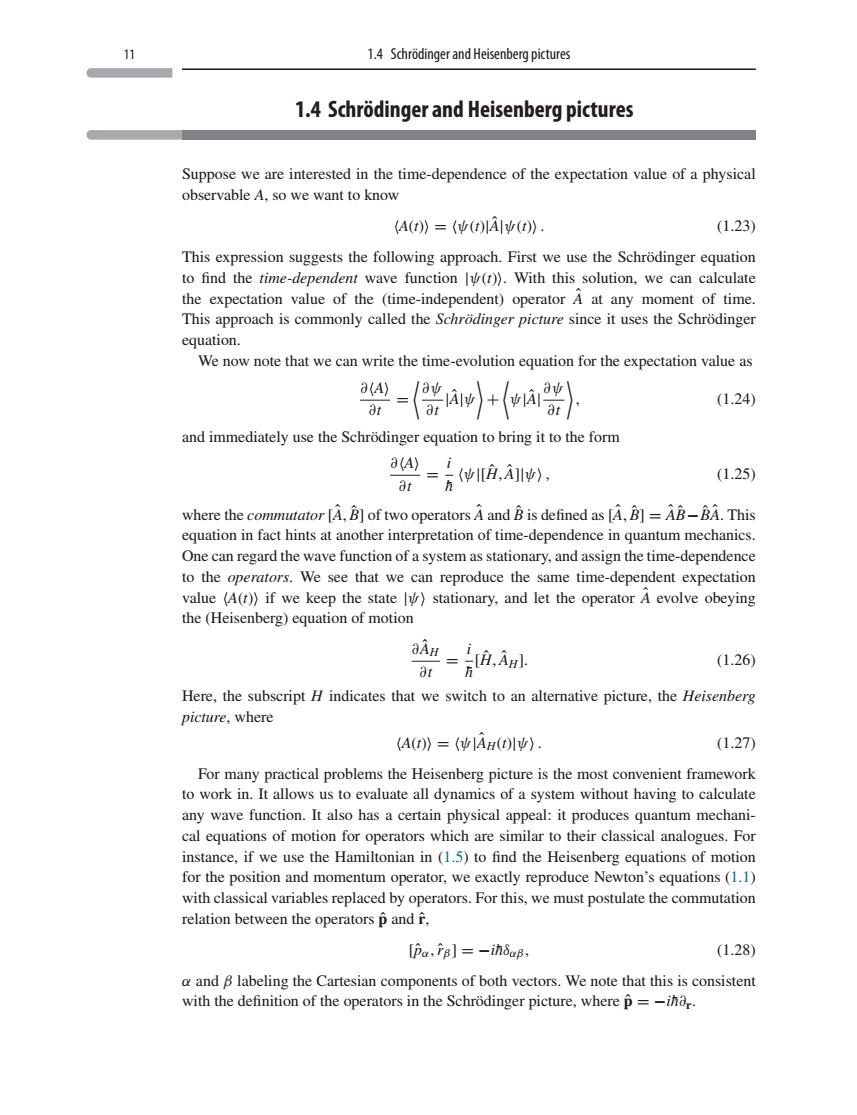正在加载图片...

1.4 and Heisenberg pictures 1.4 Schrodinger and Heisenberg pictures Suppose we are interested in the time-dependence of the expectation value of a physical observable A,so we want to know 40)=(0A). (1.23) This expression suggests the following approach.First we use the Schrodinger equation to find the time-dependent wave function lv(t)).With this solution.we can calculate expectation value of the (time-ind Tisrach is commoly called the Scrodinger pictue since it usesth the e any equation. We now note that we can write the time-evolution equation for the expectation value as =偿a+a》 (1.24) and immediately use the Schrodinger equation to bring it to the form aw-a.A: (1.25) at where the commutator [A.B]of two operators A and B is defined as [A.B]=AB-BA.This equation in fact hints at another interpretation of time-dependence in quantum mechanics. One can regad the wave function onary,and assign the time-dependenc to the operators.We see that we can reproduce the same time-dependent expectation value (A(r))if we keep the state)stationary,and let the operator A evolve obeying the(Heisenberg)equation of motion (1.26 dt Here,the subscript H indicates that we switch to an alternative picture,the Heisenberg picture,where A(0》=(1A) (1.27) any wave function.It also has a certain physical appeal:it produces quantum mechani- cal equations of motion for operators which are similar to their classical analogues.For instance,if we use the Hamiltonian in (1.5)to find the Heisenberg equations of motion for the position and momentum operator,we exactly reproduce Newton's equations(1.1) with classical variables replaced by operators.For this.we must postulate the commutatior relation between the operators p and r. [pa,iB]=-ih8aB. (1.28) o and B labeling the Cartesian components of both vectors.We note that this is consistent with the definition of the ope rators in the Schrodinger picture.where p= 11 1.4 Schrödinger and Heisenberg pictures 1.4 Schrödinger and Heisenberg pictures Suppose we are interested in the time-dependence of the expectation value of a physical observable A, so we want to know A(t)=ψ(t)|Aˆ|ψ(t). (1.23) This expression suggests the following approach. First we use the Schrödinger equation to find the time-dependent wave function |ψ(t). With this solution, we can calculate the expectation value of the (time-independent) operator Aˆ at any moment of time. This approach is commonly called the Schrödinger picture since it uses the Schrödinger equation. We now note that we can write the time-evolution equation for the expectation value as ∂A ∂t = ∂ψ ∂t |Aˆ|ψ + ψ|Aˆ| ∂ψ ∂t , (1.24) and immediately use the Schrödinger equation to bring it to the form ∂A ∂t = i h¯ ψ|[Hˆ , Aˆ]|ψ, (1.25) where the commutator [Aˆ, Bˆ] of two operators Aˆ and Bˆ is defined as [Aˆ, Bˆ] = AˆBˆ −BˆAˆ. This equation in fact hints at another interpretation of time-dependence in quantum mechanics. One can regard the wave function of a system as stationary, and assign the time-dependence to the operators. We see that we can reproduce the same time-dependent expectation value A(t) if we keep the state |ψ stationary, and let the operator Aˆ evolve obeying the (Heisenberg) equation of motion ∂Aˆ H ∂t = i h¯ [Hˆ , Aˆ H]. (1.26) Here, the subscript H indicates that we switch to an alternative picture, the Heisenberg picture, where A(t)=ψ|Aˆ H(t)|ψ. (1.27) For many practical problems the Heisenberg picture is the most convenient framework to work in. It allows us to evaluate all dynamics of a system without having to calculate any wave function. It also has a certain physical appeal: it produces quantum mechanical equations of motion for operators which are similar to their classical analogues. For instance, if we use the Hamiltonian in (1.5) to find the Heisenberg equations of motion for the position and momentum operator, we exactly reproduce Newton’s equations (1.1) with classical variables replaced by operators. For this, we must postulate the commutation relation between the operators pˆ and rˆ, [pˆα,rˆβ] = −ih¯δαβ, (1.28) α and β labeling the Cartesian components of both vectors. We note that this is consistent with the definition of the operators in the Schrödinger picture, where pˆ = −ih¯∂r